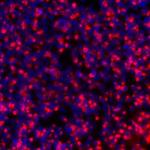
Research Topics
Dr. Pamela Robey focuses on four main areas in skeletal cell biology: 1) determination of the characteristics and the biological properties of post-natal bone marrow stromal cells (BMSCs), a subset of which are multipotent skeletal stem cells (SSCs), able to recreate cartilage, bone, cells that support blood formation and fat cells in the marrow; 2) elucidation of the role of enzymatic matrix remodeling in the maintenance of SSC function; 3) characterization of the role that BMSCs/SSCs play in skeletal diseases; and, 4) development of techniques for cartilage and bone regeneration in human patients with skeletal defects. In addition to using BMSCs for tissue engineering, Dr. Robey and her group also explore the potential of pluripotent stem cells to differentiate into cartilage and bone as another source of cells for skeletal regeneration.
Biography
Dr. Robey received her B.A. from Susquehanna University in Selinsgrove, PA, and her M.S. and Ph.D. from the Catholic University in Washington, DC. She did her post-doctoral work at the National Institute of Arthritis, Metabolism and Digestive Diseases (now the National Institute of Arthritis and Musculoskeletal and Skin Diseases (NIAMS)) on the role of defective phosphorylation of enzymes leading to lysosomal storage disease, and a staff fellowship in the National Eye Institute, where she studied retinal and ocular connective tissue diseases. Dr. Robey joined NIDCR in 1983 and established reproducible methods for culturing human bone-forming cells, in order to study the development of mineralized matrix formation. In 1992, Dr. Robey was appointed chief of Skeletal Biology Section. Dr. Robey has served as a Co-Coordinator of the NIH Bone Marrow Stromal Cell Transplantation Center (2008-2013), and is currently the acting Scientific Director of the NIH Stem Cell Characterization Facility.
Selected Publications
- Sworder BJ, Yoshizawa S, Mishra PJ, Cherman N, Kuznetsov SA, Merlino G, Balakumaran A, Robey PG. Molecular profile of clonal strains of human skeletal stem/progenitor cells with different potencies. Stem Cell Res. 2015;14(3):297-306.
- Sacchetti B, Funari A, Remoli C, Giannicola G, Kogler G, Liedtke S, Cossu G, Serafini M, Sampaolesi M, Tagliafico E, Tenedini E, Saggio I, Robey PG, Riminucci M, Bianco P. No Identical "Mesenchymal Stem Cells" at Different Times and Sites: Human Committed Progenitors of Distinct Origin and Differentiation Potential Are Incorporated as Adventitial Cells in Microvessels. Stem Cell Reports. 2016;6(6):897-913.
- Kuznetsov SA, Hailu-Lazmi A, Cherman N, de Castro LF, Robey PG, Gorodetsky R. In Vivo Formation of Stable Hyaline Cartilage by Naïve Human Bone Marrow Stromal Cells with Modified Fibrin Microbeads. Stem Cells Transl Med. 2019;8(6):586-592.
- de Castro LF, Sworder BJ, Mui B, Futrega K, Berendsen A, Phillips MD, Burbach NJ, Cherman N, Kuznetsov S, Gabet Y, Holmbeck K, Robey PG. Secreted frizzled related-protein 2 (Sfrp2) deficiency decreases adult skeletal stem cell function in mice. Bone Res. 2021;9(1):49.
- Gadomski SJ, Mui BWH, Gorodetsky R, Paravastu SS, Featherall J, Li L, Haffey A, Kim JC, Kuznetsov SA, Futrega K, Lazmi-Hailu A, Merling RK, NIDCD/NIDCR Genomics and Computational Biology Core,, Martin D, McCaskie AW, Robey PG. Time- and cell-specific activation of BMP signaling restrains chondrocyte hypertrophy. iScience. 2024;27(8):110537.
Related Scientific Focus Areas




Molecular Biology and Biochemistry
View additional Principal Investigators in Molecular Biology and Biochemistry

This page was last updated on Thursday, November 9, 2023